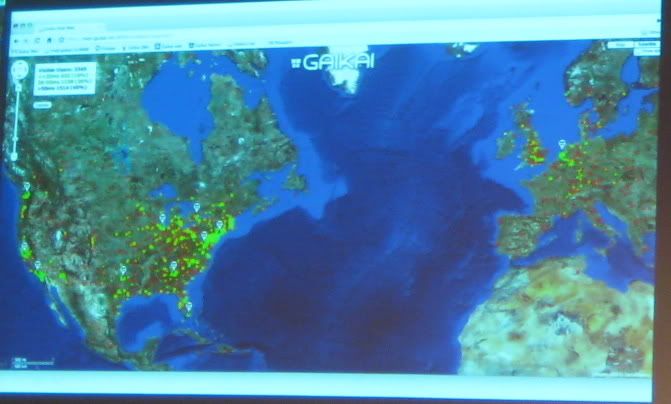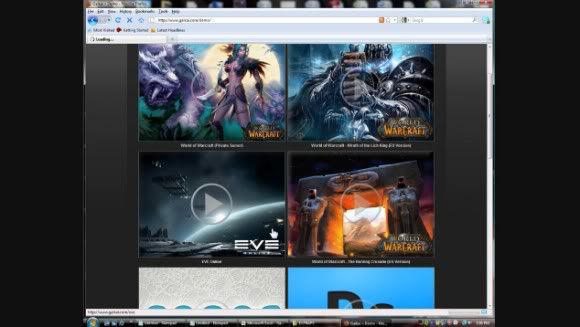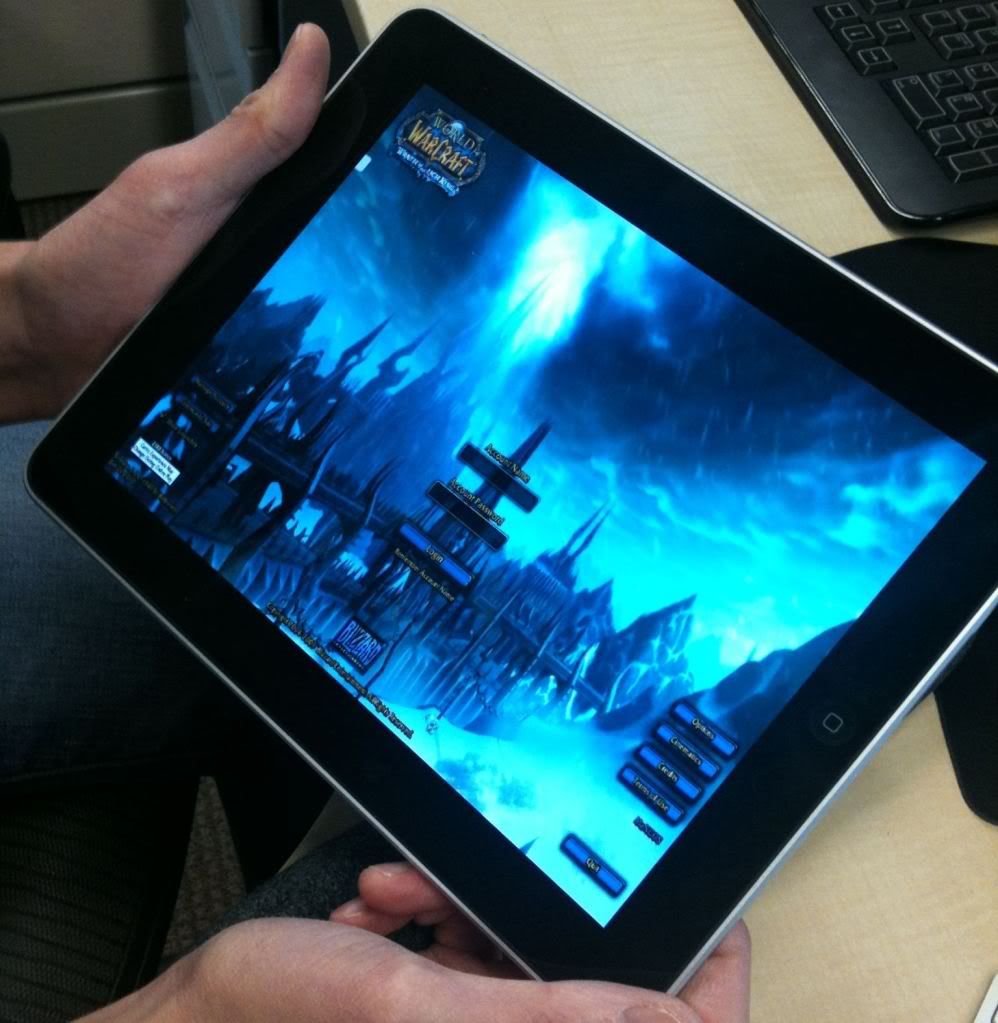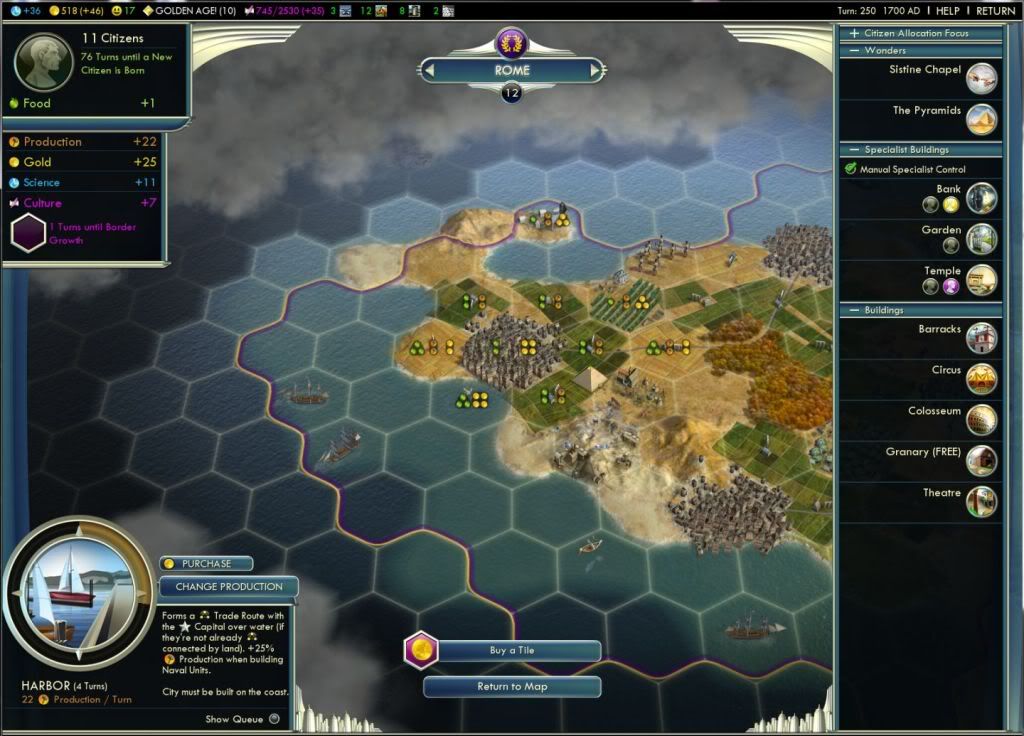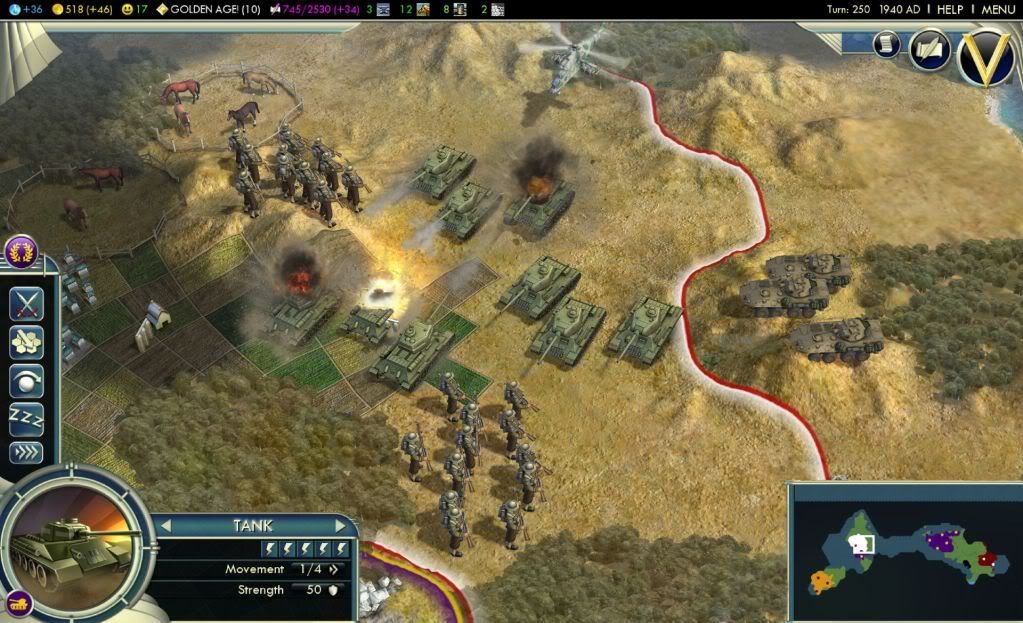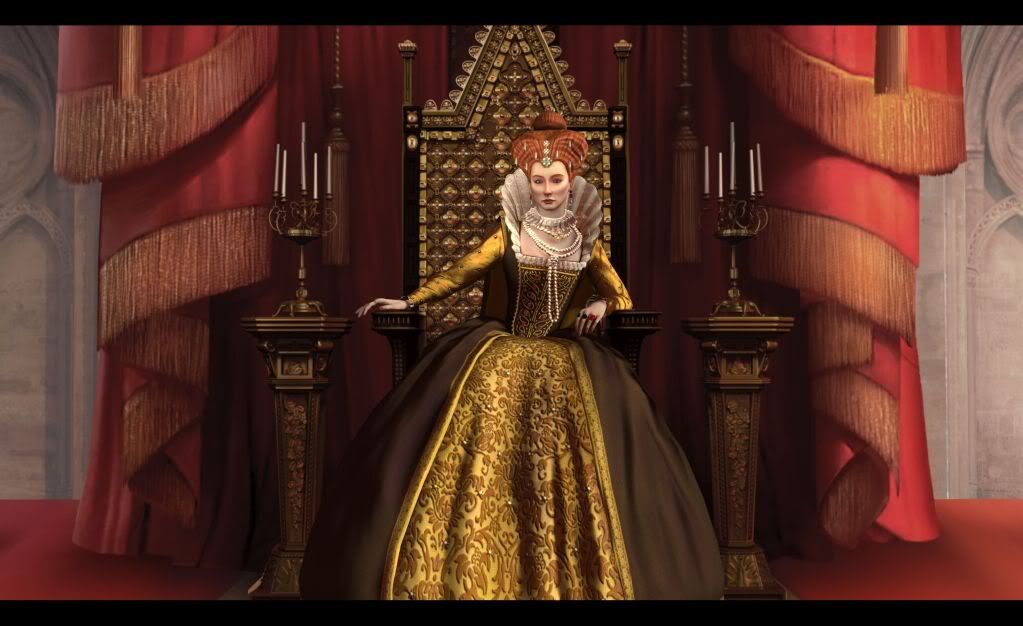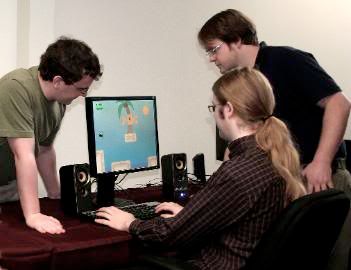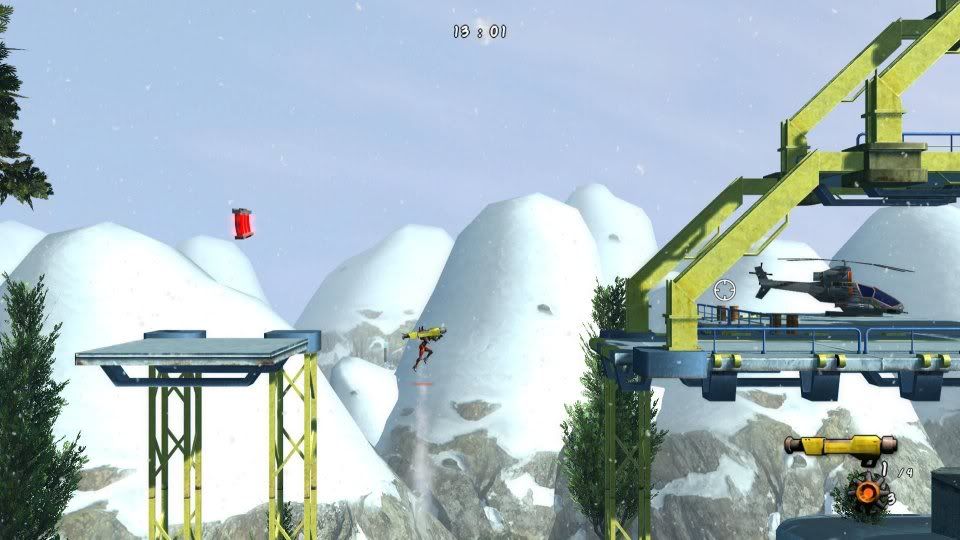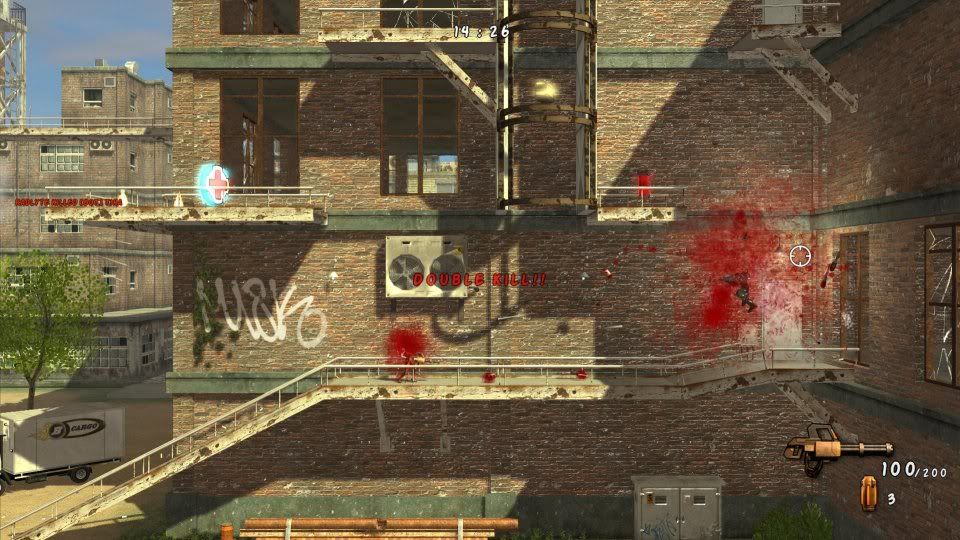
Well-known for their collaboration with Asian developers, SEGA once again teams up with an Asian developer for the title ‘Binary Domain’. Game director Daisuke Sato might seem like a familiar face. He was the game director for Yakuza 3 – which seems like something completely different. Sato shares that he is actually excited to work on a shooter, do something different. This doesn’t mean that his numerous experiences, including those with Yakuza, don’t influence the game.
Binary Domain might seem like a generic shooter at first. It takes place in Tokyo in 2080. Robots and humans live together in harmony – and then it goes completely awry. Of course. It turn out someone has created robots that look exactly like humans, and this goes against all international rules. You play Dan Marshall, who has to go to Japan together with his team to find out who is responsible.
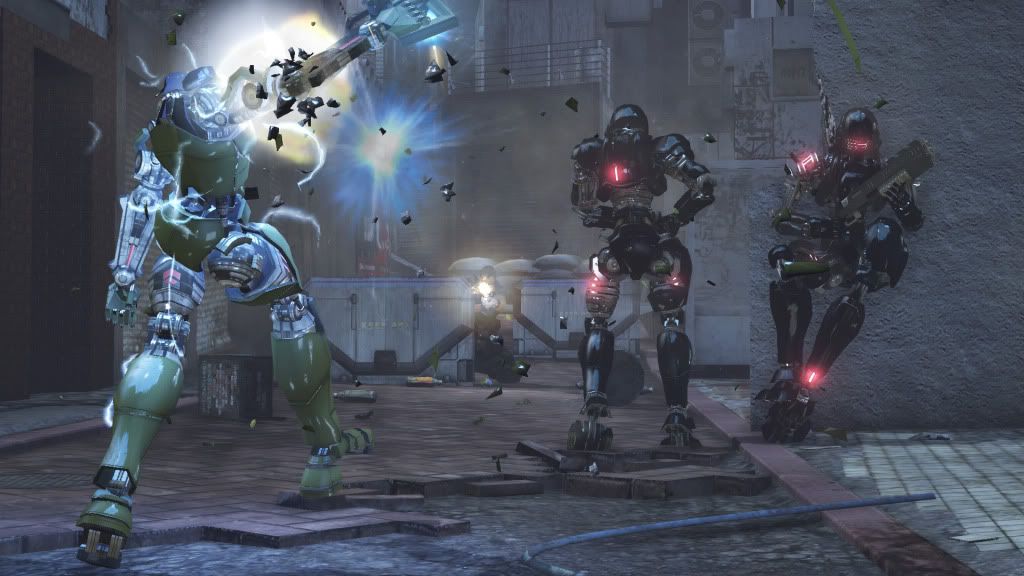 And then Sato began to talk. You can put together your own team, picking from a few operatives. As the story progresses, you can win their trust or let them down. This affects the way they respond to you and what you can command them to do in battle. Your squad, thus, actually has a purpose in this game and can be used to your advantage. From the demo it became quite apparent that the team really was responsive to your commands. The trust between you and them really is an important issue. As Sato explains, this will also influence the game itself and the cutscenes that you will watch. Sato’s enthusiasm doesn’t stop there, as he continues to explain that killing robots earns you money. And this is money you can spend on items and upgrading your gear.
And then Sato began to talk. You can put together your own team, picking from a few operatives. As the story progresses, you can win their trust or let them down. This affects the way they respond to you and what you can command them to do in battle. Your squad, thus, actually has a purpose in this game and can be used to your advantage. From the demo it became quite apparent that the team really was responsive to your commands. The trust between you and them really is an important issue. As Sato explains, this will also influence the game itself and the cutscenes that you will watch. Sato’s enthusiasm doesn’t stop there, as he continues to explain that killing robots earns you money. And this is money you can spend on items and upgrading your gear.
A sci-fi theme makes the game interesting, cool and action-packed. But the developers take it much further than that. The gameplay seems deep and elaborate, the depth to which they will go is still unknown, but the promise they hold within is intruiging. The cutscenes that we’ve seen so far show a powerful way of storytelling. The game looks like fun, and it holds a lot of promise. Although I personally believe in the skills of this particular development team, we will still have to wait and see. It can still go either way. Keep your eyes on this one, though. I’ve got a got feeling about it.
(p.s. Did I mention I’m a huge Daisuke Sato fan? I giggled a little as he signed my Yakuza 3 copy. I admit it).
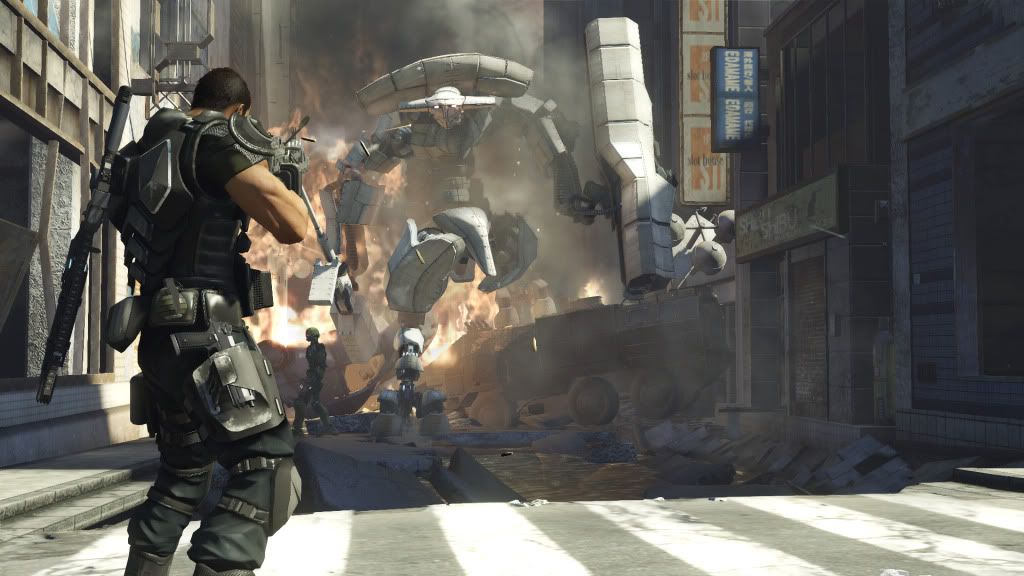

Mass Effect has always been a series highly rated for its storytelling techniques (besides, of course, the gameplay itself). Mass Effect 3 will definitely uphold this tradition.
The E3 lines for this title were huge. And I mean huge. Even members of the press had to stand in line to get a ticket, and then come back half an hour later. But it was worth it.
In Mass Effect 3 humanity has to fight the Reapers, who have landed on earth. Shepard, who is re-hired as a Commander (because he was right, duh!!), is sent all over the universe to mobilise other races and planets to fight them.

Many gameplay elements will return, which will make Mass Effect 3 feel familiar for the fans. Although there was very little information given on any new elements, we do know that weapon customisation is a lot more elaborate this time around. You can completely disassemble your weapon and customise and change it in numerous ways. The game, according to Bioware, will also require more combat tactics. To support this, Shepard can now throw grenades and use the OmniBlade, a heavy melee holographic sword.
The demo shows how Shepard yet again has to make some tough choices. As he runs into a small child hiding in a vent, he tries to help; but the child crawls away. Shepard is in doubt, but eventually continues his own mission. As he later watches the same kid run to a ship that is supposed to get him out of the danger zone, the ship is shot out of the air seconds later. Shepard knows the kid is dead, and he knows he may have been able to prevent that.
Oh, and did I mention the game looks gorgeous?

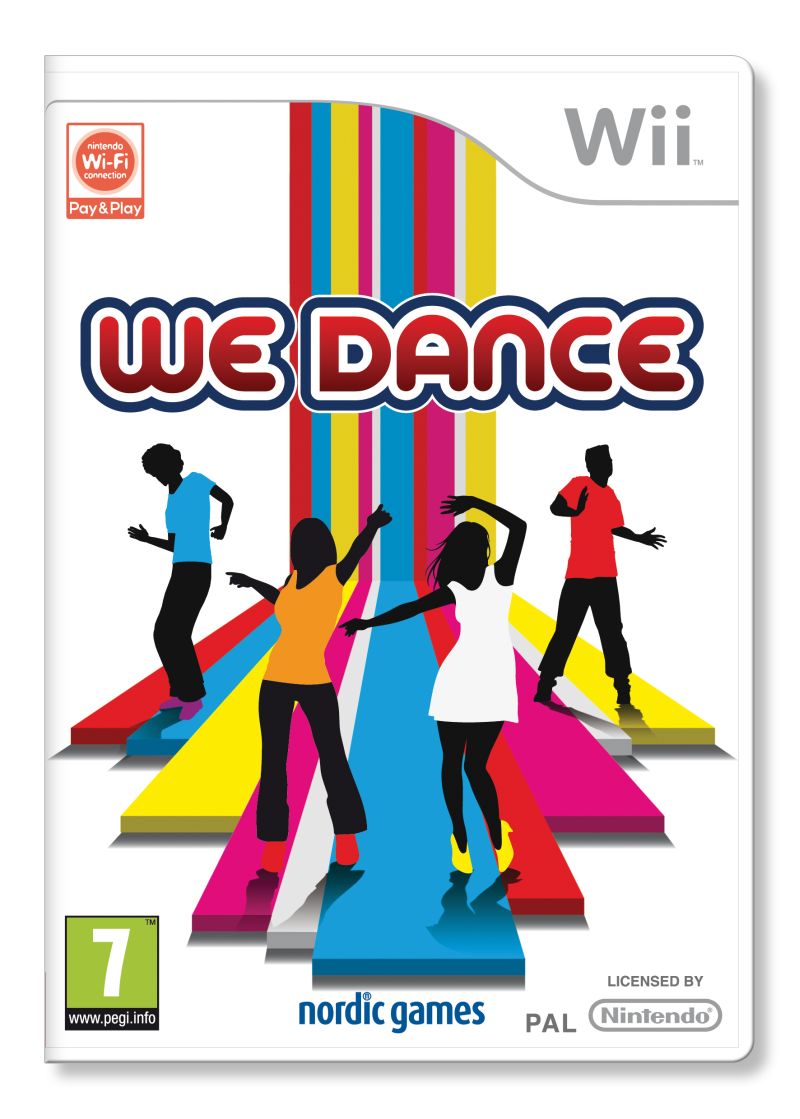
Swedish developer Nordic Games showcased their upcoming line-up during this year’s E3. Known for their expansive development of Wii games, they continue their specialty by releasing numerous We Sing games for the Wii. Covering a wide array of genres, Nordic Games plans to bring out We Sing games for pop, rock, British songs, American songs, and plenty more to come.
The bigger game they were showing, however, was We Dance. Remember DDR? It was one of those games that got you excited about playing (and really tired). The dance mats and the songs were often quite challenging. We Dance wants to bring this challenge back to dancing games, with their very own dance mat and the power of the Wii. We Dance doesn’t just require you to dance with your feet; you have to use your arms as well.
With a booth that was made entirely of glass, it looked all the more fun to see people swing around their arms and jump like crazy. We Dance isn’t just for the dancing talents, however. It features several levels you can try out. You can also pick and choose whether you want to dance with your feet, your arms, or both.
Upon release the game will feature 40 songs, but there’s more to come! You can download new songs and new steps from the ‘Dance Shop’. You can even play with up to four players at the same time, if you’ve got the living room to host it. Or just play by yourself, start out in the ‘Dance School’ to get a tutorial, do a warm-up session, and then go for it. For those that are really into dance games – you can freestyle all you want, it’s in there.
]]>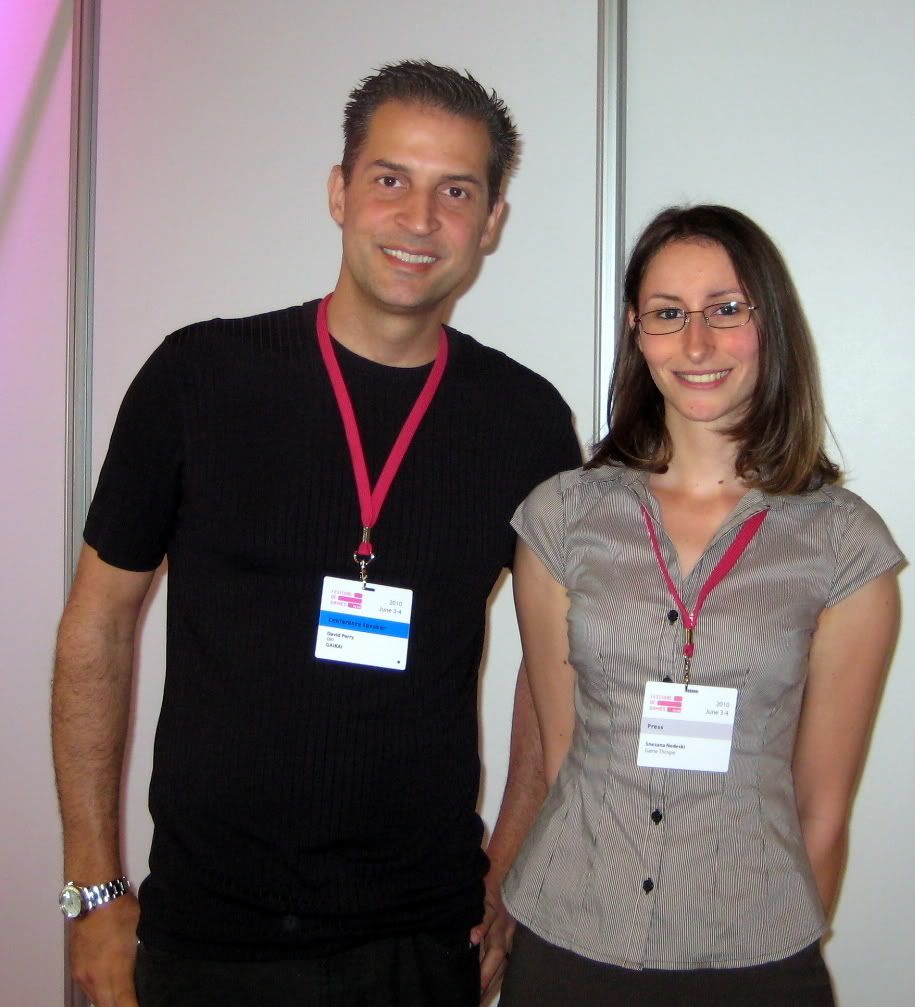
With David Perry after the interview. It's okay to be a fan of game developers.
Gaikai, as its own website mentions, is streaming, cloud-based gaming technology which allows gamers to play, preview, and demo PC and console video games for free. Now, what is Gaikai exactly? We talk to CEO and co-founder of Gaikai, David Perry. He discusses Gaikai, which according to him finally makes computing (and gaming) ubiquitous. He discusses what it does, what it changes and the many more possibilities it will have in the future.
What does Gaikai mean? “One of the original founders came up with this name. It’s a Japanese word for the vast, open ocean. Think of it as a word meaning a large open space to be discovered, and that’s what we kind of believe that this is all about. We’re kind of saying to people, “Join us in this voyage to try to explore this space.” The concept is that [on] anything with a screen, you can experience a 6,000 dollar computer [that’s situated] somewhere else. So you don’t need to buy this ridiculously powerful machine, but you have all the power of it in your hands.”
YOU buy this 6,000 dollar machine? “Yeah. We buy the machine, we’ll part with that money, but wherever you are, on a little notebook, you’re able to have so much more computing power. That concept of experiencing one device through another is kind of the whole idea.”
How come no one else has ever thought of that? It sounds … logical. “Yeah. It is logical. And it has been thought of. If you go to an airport, they’re sitting typing on terminals when they’re checking your ticket and it’s a very simple terminal with very basic capabilities. But, it’s connected to a supercomputer somewhere else that’s running the entire technical system for British Airways or who-ever. And that’s basically the same concept. It’s just never been done in 3D, with Call of Duty and everything else. The ones at the airport can’t play Call of Duty on everyone’s computer, it just can’t do it. There was no company I could go to, there was no infrastructure I could rent, hire or buy or anything that could just take care of this problem. It all had to be created from scratch: the management software, the server designs, the relationships with the data centers, everything had to be done from scratch.”
So, you’re the first ones who are creating a service like this. Which obviously means that there will be quite a lot of problems at first. What are the problems that you are anticipating? “The biggest problem I think is a business model. Trying to come up with the right business model that works well for this is hard because it’s so new. I have one competitor, so there’s two companies doing this; there’s OnLive and there’s Gaikai. OnLive charges a subscription to use their service and I was just reading the terms of service today, and their terms of service clearly state: if you stop paying you lose everything. You will walk away from everything, all the games you bought, everything is gone. And that’s never been done before. And that’s the problem, trying to come up with a business model.
“They’ve come up with one but I just can’t understand the logic. Imagine you paid a subscription to load iTunes, so you have to pay fifteen dollars every month just to load it. You can listen to previews, but you can not play any music, you have to buy all the music. And if you ever stop the subscription, all the music you’ve bought gets deleted. That’s the model they’ve decided to come up with. And I don’t know how they’re going to try and explain it to people in a way that makes that feel good.
“The second point is, if you read their terms of service, ‘we don’t guarantee you an internet connection, because the internet is unpredictable’, blah blah blah. So that basically means you’re not going to have access to your music whenever you wanted. So you don’t own the stuff you buy and they can’t guarantee that you’ll be able to hear it when you want to; that’s what they’re offering. And that’s really the difference with Gaikai, there’s two ways to go.
“At every point there’s this way and [the other] way, and everytime they went this way, we went [the other] way. It’s very interesting to see how two companies that are doing something similar could do them so differently, and that’s what our whole mantra is. So first of all, our services are completely free. The users don’t pay anything. If you want to try the newest games from whatever publisher, you can try them on our servers and pay nothing. There’s no subscription, no registration and no download or install. I don’t want your personal information, I don’t want to hassle you about anything, just play it. If you like it, buy it, if you don’t like it, we’re done.
“What I’m really replacing is the banner advert that would have been on the page. My competitor is Google, that’s the company I’m going after. When people pay for those banner ads, those are really expensive if you look at how the math works out. And if I can take a piece of that money that is getting wasted on banner ads, when I can turn a visitor into a player it’s much more valuable. So that means I don’t need to inconvenience the player at all for the cost of play, and that is more compatible with people today. People love free.” * Perry shows a video demo of Gaikai as he used it in his own home through a server in Los Angeles. He smoothly switches between games. He goes from World of Warcraft to Spore, no installs, no updates, no hassle, just instant play.*
“So this is not running on this computer, this is running on a different computer. But I’m able to decide; is this the kind of game I’d like to play? So if you think about it, you’d probably try more stuff. This WoW is 15 GB to download because it also has two expansions installed with it. So if you wanted to sit down and get them you would be busy all afternoon with downloading, installing and the patches and everything. But with [Gaikai] you just click it and you’re able to take a look.
“We’ve also worked with Adobe for the last year to get Flash to support this. We’re using the fastest hard drives money can buy, so you get a better performance than a typical desktop would get. You’re gonna find it hard to buy a computer as fast as the ones we have, because it’s the latest in video cards, the latest Intel processors; it’s absolutely top of the line as far as computing goes. Which means that to most people on a computer that’s maybe one or two years old, it will be a premium experience. That’s the idea.“
How far along are you with finalizing the Gaikai platform? “It fully works now. So it’s not like this is still years away or something, I can already do it. You see it in the video; that was me playing it at home.”
So there is already a lot of support from publishers for Gaikai? “Yeah, we’re going to start announcing some of the partnerships. There’s one rule in this business, which is the Achilles heel of this whole thing: this only works for good games. My helping you play a game that is not good is not going to help the publisher at all. It only helps good games, and that’s important. And it’s important for us, because we want to get known that every time we offer you something you know it’s probably good. So we’re not going to be operating a thousand games. The idea is to keep the number of games low, but very good. That’s what will make the publishers want to pay us. We have to be paid, just to be clear, but we get paid by the publisher so that means we won’t have to trouble the consumer at all.”
So on what scale will you be launching? How many servers are you planning to have? How many do you have? “The way it works is: the closeness to the server is actually critical, it’s a key thing. So my target is to have 300 data centers in the world. It will take 50 or so just to cover the US. Right now, today, we have 11 data centers live and we add new ones constantly. Amsterdam just came online in the last few days, Paris is next and then London. So we just keep adding data centers. Denver is coming online soon and so is Minneapolis. We just keep going one after the other.
“We have a map of the US. The white dots are the data centers, and every time we add one on it starts lighting up green dots around the area. It has weird and strange patterns because of the way the Internet is wired. So it’s not like you think; you can’t just make a big perfect circle or something. It makes a strange pattern and you can start to see where servers are needed. So we’re launching this month with around 30 million minutes of server time. And that’s what we sell publishers; minutes. By Christmas I will be selling 300 million minutes a month of demo time across the US, and then I will try to replicate that in Europe and that would give me a total of 600 million minutes a month. And that’s plenty of inventory. That’s a lot of demo time.”
Besides streaming games, what future applications do you have in mind for this? “There’s lots of doors that it opens. It affects game development in every possible way. The fact that I’m sending video to this computer here means this user is having that experience. But that video can also be sent to the game designer as well as the users. So the game designer is actually able to watch thousands of beta testers and monitor what’s going on. For example, all these beta testers are playing, but they keep getting stuck somewhere. He can see this and watch whatever the problem is, then he can actually fix that piece of code and reflash the network so the users don’t even need to know. They don’t have to download anything, they don’t have to patch anything. Next time they play, the game designer will be able to actually see whether it has fixed the problem or not. So the idea of real-time tuning is very valuable.
“Another one is real-time crash analysis. If you crash a game, currently they get reports back saying ‘well I was jumping up and down and it crashed’, right? Which is no help at all. So is there a way to improve that using this technology? The answer is yes. So if you crash the game we know on our server that you crashed it, so we can take the last thirty seconds of video and automatically forward it to the developer. You don’t even have to type in reports anymore.
“Then there’s other things too, like cybercafés. I went to a cybercafé and they have 250 gaming boxes and they have to replace them every 18 months because people are paying to use them and therefore they have to be really good. If they want to update a game, like when a World of Warcraft patch comes out, they have to log into each one remotely and patch it. That’s 250 times that you have to log in and patch things, and that’s crazy. If they would use technology like this, they could just buy machines that are simple, that just play Flash or whatever, and then they patch it once on their main server and all the boxes in the room are updated. It could change that whole space completely.
“It is the same for computer software. A demonstration I do is Photoshop loading really really fast, which means now I have Photoshop everywhere I go. They’re 600 dollars a pop, so I don’t want to have a licence key for my office, my home ánd my laptop. I want to be able to just pay them the time I use but have it everywhere I go. And all the files are safe in the cloud. So if I go to England or something I’ve got everything in the cloud ready to go. So that idea of software being ubiquitous, I can then pick up my iPad and continue my Photoshop where I left off. That is kind of neat. The idea that the game goes with you wherever you go, is something that is absolutely do-able today. This is not like something in the future, we can do that right now.”
The whole concept of ubiquitous computing has been something that we’ve all wanted since the dawn of the internet. “I know, and now you can actually do it. Another thing you can do is the sharing of games. My vision that I’m really pushing on the publishers is that I want you to be the first one to discover a new game. You’re the first one in the new Diablo game, for example. First one of all of your friends. I want you to be able to tweet: ‘oh my god, I’m in Diablo 3′, then hit enter, and it sends a link, and if your friends click that link, they are teleported to you inside that game.
“So imagine you’re playing some MMO and you’re running around and you tweet out from within the application ‘hey join me’. Your friends, just like in Star Trek, can beam in around you, and none of them have to register or download or install. None of them know what publisher makes this game, they don’t need to know. They just arrive and they’re now in the world and you’re all playing together. That idea of sharing with no friction is completely possible with this technology.”
There are probably a lot of ideas going around in your head. For example, combining this technology with social networks. “I have a demonstration I’m going to show at E3 of playing MMO’s inside Facebook, without leaving Facebook. So it loads faster than Farmville, because Farmville has to load a flash file. Ours is just connecting you to a video stream out there. It means that I can put Call of Duty or Madden or whatever you want to play in Facebook.”
I immediately have these horrible flashbacks to the CoD:MW2 multiplayer system, IWNet, which has really horrible and problematic connection issues. How stable are the Gaikai Servers? “Well that’s a really good question, a very important question actually. It’s a big concept difference between what we’re doing and OnLive. OnLive is offering service, so ‘come pay us a subscription and play’, which means you really need the answer to that question. It’d better be good or you’ll get really mad, right.
“This is what we do using your website as an example. You have a website where gamers go to. I have publishers that would like access to your gamers. Imagine you’re writing an article about a new downloadable game and you can put one line of Gaikai code on your website, which is one line and no change to the website whatsoever. Every minute that anyone plays that game online on your site we will pay you. And we don’t just pay you a little bit, you get exactly what we get; a 50/50 split.
“Another thing is that the players play the game on your website so the time spent on your website goes up. And the thing that’s important is that the gamer has no expectations of this, so if they’re in Alaska or Egypt or somewhere where we don’t have servers, they just use your site like they’ve always used it. And it’s not like your site says ‘Click here to play this game’. What happens is, they’re reading your article and while they’re reading the article I go have a look and see if there’s a Gaikai server near this person, and if there is the button appears. So the button only appears for the people who are close to one of our servers.
“So because of that we took away the whole problem of ‘is it going to be foggy or not?’, because we pre-test the quality before they get the button; we know they’re close and we know their connection’s good. Every time the button appears we look at where they’re coming from and we can see that we need to have some servers in Alaska or in Egypt.”
How did you start with this idea? “Well, this is what I learned from [working at] Acclaim. The last game I launced at Acclaim was 3.5 GB to download. That really, really, really is a problem. At 3.5 GB, what actually happens is you spend money trying to get them to click, and we would force them to register too, so you would have to register and we’d lose a lot of people there. Then you have to download, and no one can download 3.5 GB like that. Which basically means that they’re all going to do something else. So what you’re relying on is for them to come back to you and then continue where they left off, which actually a shocking amount of people don’t do. They never come back. So they’ve gone through the pain of downloading the file, they’ve got it on their hard drive and they never ever click on it.
“The point is even when you think you’ve succeeded you can still lose. I can’t tell you what is going to happen, I honestly can’t tell you, but I believe very strongly in what we are doing. I think it makes sense. The only problem with the publishers is that they are on two levels. First the publishers that still have the good [development] teams available. We want them to think about ways to modify their games to keep them as frictionless as possible. Then there are publishers who don’t have the original teams anymore, so that as soon as the game is done the team disappears. It means we have to deal with any issues with the games ourselves, and that’s hard work. We had to set up a system to fix other people’s bugs. You have to go into the code, and that’s extra work. Most people don’t even know what we’re doing. A lot of people think we’re just making another version of OnLive or something like that.”
You started in Amsterdam, why there? “My two co-founders are from there. They met each other in Amsterdam and they got this whole thing running and then they got me in. They had a whole different vision. Their vision was to let you play arcade games online so that you wouldn’t have to find an arcade machine. That was what they were trying to achieve. They were working on this very core technology to see how you could do that, and it was very cool. Then they called me and said, would you like to see this running? I had just given a speech about the subject and so I didn’t believe them, and they’re like: “No, no, we saw the speech, and we’ve been working on this actually.”
“They had just gotten WoW running so they sent me a link and that’s what got me involved. From there we evolved the business model, got the funding we have, and 21 staff working on it. So it’s a proper company. At this point it’s just a case of executing and getting all the servers up. The servers are hand-built, all of them.”
]]>
Civilization V looks to improve yet again upon its predecessor. During E3, one of the producers at 2K tried to tell us what it is that makes Civ V so much cooler than all previous Civs.
Simplicity is one of the changes to the game. And that doesn’t mean they’ve made the game easy and casual, it just means that they made the game clean up its act. This means UI improvements that are simple and clear. The most commonly used functions are now shown in the front, moving into the depth with a second row that shows less used functions. This second row is normally hidden from view, but pops up when you want it to.
Tech trees are another way of cleaning the game and giving the player a better overview. You can assign priorities in the tech tree to influence what your civilization will become like. Although simplicity is a big point, control and detail is not given up. Besides control over your tech tree you can tune your civ with ‘social policies’: upgrades for your civilization that you buy with culture.
Strategy
Civilization V wouldn’t be part of the Civilization series if it didn’t have strategy. The first change they made, according to the 2K producer, was a big one that yet looks small in many of our eyes. Civ V says goodbye to the good old square tiles and adopts hexagons.
But don’t worry, this isn’t the most exciting change to the series. Civ V introduces city states, which are cities that are AI controlled and you can interact with them like you do with every AI. Except now they won’t be part of the enemies you have to defeat to win the game, but you can use them to your advantage. This means befriending them and utilising them for trade or for gaining culture. However, a friendship with certain city states brings with it the responsibilities many countries experience in real life. If your buddy declares or is declared war, you have to choose to support them or not. If you don’t, they won’t take that decision lightly.
Although city states primarily seem to be there to befriend, you can also choose to have a bit of irrational fun with them and attack them. You can either show off your military muscle and force your way into the city, or act like a fancy playboy and simply buy your way ‘into their hearts’.
As mentioned before, there has been a switch from square tiles to hexagons. More tile changes, as exciting as it sounds, have been made. While Civilization always allowed us to build huge armies and simply ravage the entire map, part five takes a slightly more subtle approach to warfare. You are now only allowed to place 1 unit per tile, making every piece of military and tile important. So it’s no longer just about large numbers; the kind of units, tactics and their position is much more important.
Bonjour, Napoleon
Leaders have always been present in the Civ series, although you never really got to interact with them while playing the game. This time that’s about to change, according to the 2K producer. Characters like Hiawatha and Augustus Ceasar, also playable, will now interactively engage in conversation when you run into them while, just to name something, trying to invade their land.
As the preview shows a wonderful CG Napoleon talking to us in French, leader to leader, the extended contact with the AI is further explained. Of the 18 leaders present in the game, each of them has been given a unique personality. This personality pops off the screen in the new diplomacy screen that is armed with a full 3D environment and animated leaders speaking in their native tongue. Every leader comes with their own animated environment, so you will meet Gandhi by the river and Napoleon on the battlefield.
Also look forward to..
Multiplayer and modding. Both great additions for the big Civilization fans. Developer Firaxis has made it even easier for the player to find great mods: you can see all the mods in game.
Although there is still a lot they weren’t talking about, let me name a few things to look forward to:
Tanks, choppers, building a spaceship as a technologic victory and nuking someone. Nuking the heck out of them. A sneak peak of throwing a nuclear bomb on a technologically advanced opponent that posed a serious threat, was by far the most impressive preview of the game. But that might just be because nukes in games are so very awesome. Expect more this fall, as Civilization V is released.
]]> Jan-Pieter van Seventer has ten years of experience in the Dutch game industry as a designer for consoles, PC and handhelds. He has been working at game company W! games as a production director for years and teaches at the Game Design department at the School of Arts in Utrecht. Since 2008 he is also the strategic director at development center Dutch Game Garden.
Jan-Pieter van Seventer has ten years of experience in the Dutch game industry as a designer for consoles, PC and handhelds. He has been working at game company W! games as a production director for years and teaches at the Game Design department at the School of Arts in Utrecht. Since 2008 he is also the strategic director at development center Dutch Game Garden.Today, he talks to us about game education and development. He discusses what could be changed and how much more effective both could become.
We’ve talked about it several times before: something’s not right with game education. Can you explain what’s wrong with it?
Van Seventer: “There has been so much invested in education for art, design and programming that it is about time to focus on the forgotten disciplines like game management and marketing. Managing game teams brings with it its own specific challenges which aren’t discussed in traditional management education. Things like managing the production of an interactive entertainment software product, for example, is so profoundly different from managing business processes or software that it is quite easy to develop a four year program for it. Marketing expertise with games has become a separate business since the market of games is so different.”
What are some of the most common mistakes when developing games?
Van Seventer: “Going into production way too fast. Not enough is being thrown away. When people start to realise that a failed prototype is not acceptable and maybe the reason why the next prototype was made into a hit game, they can give a little bit more space to experiment and check everything more thoroughly before executing.
Another mistake is thinking that games are plannable in the same way as the build process of a new house is. Because of the at times surprising outcome of an interactive product, including the unplanned actions of players, a game is something that has to be developed iteratively (players and developers are seen as equal partners). Methods from the Agile Development like Scrum can be an answer to this and better play into the nature of the product.”
How can teams that are already in business be improved? And how does education play a part?
Van Seventer: “Applying Scrum in current teams is a possibility. And regularly hiring young people from certain studies to the current teams keeps the team fresh and sharpens the veterans a little. Schools would do well to apply Scrum-like development processes to give that experience before students step into the company life.”
What role is often missing from a team?
Van Seventer: “A good producer; someone who can have a good overview over the processes and can tie them together. Depending on the team it is wise to trust this role to someone fulltime at the beginning of the company’s existence instead of trying to push it in way later.
What is, in your opinion, the ultimate team? Which roles are fulfilled and how do they work together?
Van Seventer: “A team that runs on trust and where the creation, production and business balance is divided through the team. The ultimate team knows what they’re good at and what they aren’t good at.
Every good game team has a lead in the area of design, art and technology, and someone who overlooks the whole, a kind of executive producer. This is needed when your team is large enough (from 15 employees). When you start a new team and you’ve covered these four main groups from the start, you’re on the right track.
A big risk is starting and growing your company with a missing link. Especially adding someone later on in the business area is tricky because the original starting employees won’t easily trust a newcomer in that area.”
What does the ultimate game education entail?
Van Seventer: “Multidisciplinary development and a close cooperation with professional game companies. Business and marketing disciplines should be included. Doing assignments for real game companies can be very stimulating.
Also, at least half of the teachers should be from that part of the sector in which they want the students to work, eventually. So for example, have people with console game development experience teach if it is the intention to have students who can look for work in that sector.”
Is there more use for specialised people, or people with a broad knowledge base that combine different specialties?
Van Seventer: “Both. big game companies need specialists and some broadly trained employees. Small companies have more use for the broadly trained. It’s very interesting to see that broadly trained people are often entrepreneurs, so they start a business for themselves. For now we will need more small game companies because a lot of innovation takes place there. It is a good market right now for small companies because of the movement to downloadable distribution with smaller games.”
Any closing remarks concerning the future of game education?
Van Seventer: “For the future of the game industry it would be a great move to have classes taught about making games as early as elementary school. This would greatly improve the knowledge and quality later on in college. Children could learn to make a game about a certain subject (like the Romans, or about trade) instead of writing a paper about it. They would learn a lot more about the subject and the connection between certain components. I think games are a great platform to make complex systems clear. It would be good for both their general knowledge development and for the quality of future game developers. What would be necessary for this would be easy-to-use game tools and editors, and teachers that aren’t afraid to try something new. Making games, not just playing them, is the future.”
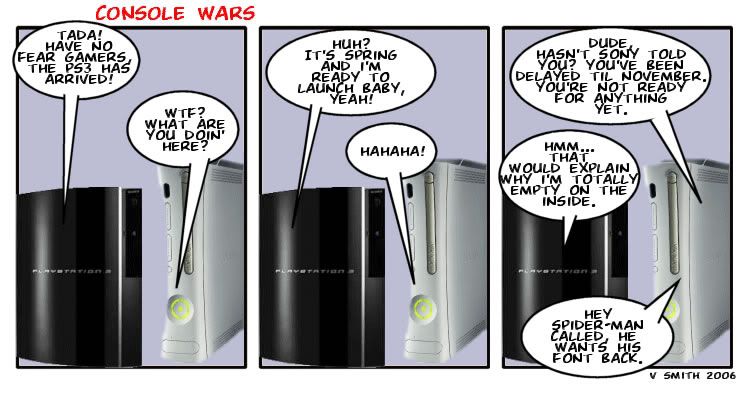 Games industry veteran Don Daglow talks to Snezana Nedeski about the first console wars and crash, and about the deaths and revivals of 1980’s game companies like Intellivision and Activision.
Games industry veteran Don Daglow talks to Snezana Nedeski about the first console wars and crash, and about the deaths and revivals of 1980’s game companies like Intellivision and Activision.In the 1980s when you were working for Intellivision, the first Console Wars started. Can you tell us what it was like experiencing the console war while actually working for a console company? How did it affect the games industry?
Don Daglow: “You know it’s funny because it was all exciting and all fun. We had no conception of it. Both sides were winning. Both sides were making a lot of money and both sides were growing. They were selling more, growing more and making more than we were, but both of us were doing great.
For me it was very surreal. In ’79, I was writing games as a hobby but I was teaching middle-school. And when I heard about a job as a game designer at Mattel, I immediately applied and got hired. I was lucky to be at the right spot at the right time. So I’m going to work every day pinching myself because I’m doing games for a living. And I thought, I’m just a schoolteacher, when will they find out I’m just a schoolteacher, not a hacker/programmer. They’re paying me to make games!
And then we were competing with Atari. But there wasn’t this sense of hatred, it was just an, ‘of course our system is better than theirs’. And yes we had secrecy and it was important that ‘evil Atari’ sometimes came and took away some of the programmers from our teams. Of course the companies were doing things to each other, but we didn’t particularly feel hostility. So there was a rivalry but it was more like sport teams competing. You don’t really want to hurt anybody and everybody’s winning but you want to be the best.
The strongest memory I have is not so much about the wars against Atari, even though that was all we talked about. The strongest emotion I remember is going to work everyday thinking, how did this happen? How did I grow up from being a classroom teacher to doing this in like a year and a half? And I’m sitting in these executive meetings at Mattel, where I had to wear a coat and tie, and I’m just thinking; was I struck by lightning, am I dreaming? That was the dominant feeling for me because it just came out of nowhere, that this thing I loved to do suddenly became a career.”
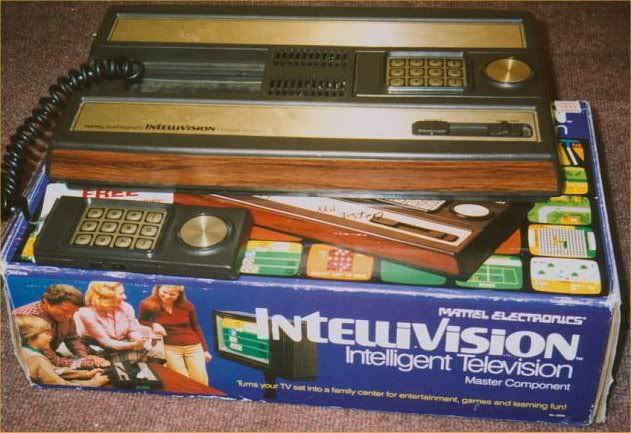 There were the console wars in 1983, then the video game crash occurred. Intellivision didn’t survive.
There were the console wars in 1983, then the video game crash occurred. Intellivision didn’t survive. Don Daglow: Nobody in that time really survived.
Pretty much every console that was around at them time ‘died’.
Don Daglow: “The one that came through by name was Activision. Activision actually lasted for a few more years because in the US at that time there was a tax law that if you were a successful company and paid a lot of taxes and then you had some bad years, you’d get some of your tax money back. Activision lasted another 3 or 4 years. At one point I almost went to work for them, I was offered a job with them which I ended up not doing. So they survived for another 3 or 4 years because of this tax law and because of their good years.
But then they died and Bobby Kotick created the current, what we now know as, Activision. They bought the name and all the assets and Intellectual Properties. And I think they took 4 employees from the old company, with which they formed a completely new company. So they were reborn.
Just like Intellivision was reborn twice. Because the old one was sold off when Mattel, the toy company, had almost gone out of business. We had started out with 5 people dedicated to Intellivision. The whole company I think was about 35. So then we grew from 35 to 1200. this was from late 1980 to middle of 1983. Two years later, Mattel sold off what was left of Intellivision to a guy who had been the Marketing VP and four jobs went with him. So it went from 35, to 1200, to 4 in a grand total of 3 years. And he kept going for about five more years. We had a bunch of games that were half-way done. So he paid the programmers a little bit of money to get them to finish the game. And then he went out of business. And then, a few years after that, one of the old programmers went back and for next-to-nothing bought the name of Intellivision, logo’s, the right and all the properties and formed Intellivision Lives as a completely new company. But the old Intellivision really did die.”
So you didn’t take the job at Activision at the time, and the industry was crashing, but you were recruited by EA Games.
Don Daglow: “I was so lucky. The executives get told that the whole industry is dead and doomed. We had been giving oaths of loyalty, because they wanted us to swear our loyalty. It was like joining the military. And I was like, I don’t intend to go, I want to try and fix things and make it better, I guess I’m loyal, yes. And we had this new president who gave big speeches. And then we got the word that it’s all going to go, and that we’re released from our oaths of loyalty. ‘But you can’t tell the teams! Only the executives can know about it’. So much for his speeches.
And I called a meeting with my team and I just talked about how bad things were and about how we used to be able to sell things, and now there was nothing we could sell. And I kind of repeated myself, which they weren’t used to hearing in a meeting. And one of the guys started to get what I was trying to do. We had already had two waves of lay-offs, these teams that we had lovingly built were starting to fall apart. Awful. So he said a thing like; ‘so what you’re saying is that it might not get better?’. So I told them I had to go to a meeting and that they could keep on talking about it without me, cause I had seen that he started to get it. And I walked out of the room and they figured out what it was that I was trying to say. And my VP knew what I was doing because he was as disgusted as I was that only the executives get to know. I technically did not disobey orders.”
At Stormfront Studios you made the first 3D RTS, Stronghold. A pioneering game. Somehow, you’re one step ahead of the competition. How do you pull it off?
Don Daglow: “A programming trick, that’s where it started.
The first time I saw ‘Les Miserables’, when they’re marching with the big flag on the turn-table and the wind is blowing because of the big fan on stage. And it looks like the stage is so huge and deep and there’s all this emotion and music and everything. And really, that turn-table isn’t very large. And there weren’t that many people marching on the turn-table. But the signing, the music and the set design and the angle at which you can see the theatre made it feel so much bigger. And so much farther, yet so much closer.
So I started thinking about it. And we couldn’t do real 3D, just fake 3D. So what we did, we drew in bitplanes. You could use perspective to create a sense of depth and distance. And that can be done mathematically in terms of scaling. And so I pitched that idea to the guys and everybody got excited about it, so that’s how that happened.”
You were there when it was just Pong in 1975. You’ve seen the video game industry change. Is it possible for you to briefly describe what has changed?
Don Daglow: “Before Pong, all we had was text. Even the idea of what is now Pong was foreign to us. So there was a jealousy of admiration for that technology. And then I actually got in to play in that world and from then it feels like one big continuum of one constant speedy change. Everything changes faster now. The 80s were faster than the 70s, the 90s were faster than the 80s, and so on. Which is actually a good thing because it keeps making things more exciting. And you have to learn new ways to do things, which means you can’t just keep doing things the same way.
Whatever we’re doing today will seem pale by comparison [in the future]. Right now what we’re doing is exciting. So we get the joy of the present and the mist of the future.”
 When you started your career in the games industry, you must have speculated about what would become possible.
When you started your career in the games industry, you must have speculated about what would become possible.Don Daglow: “Oh, we underestimated it all so wildly. First of all, between 1971 and 1975 the idea that you could have a computer in your house? Yeah right, a computer small enough that you can afford to put it in your house. Every time that I’ve assumed how things will evolve in terms of technology, the changes have always been bigger and faster than we have assumed. So now I just always assume it’s going to be bigger and faster. The principle that we have to abandon the assumption that the way we do it now is okay; what we’re doing now is okay for now. But as soon as possible we’re ready to do something faster, better, more complex, or just different. The Wii is not faster, not more complex. It’s less of everything, but it’s more engaging. There’s not just better resolution, better hardware, better graphics. It’s not just objective; it can be subjective too.”
Thank you for your time, Don. And good luck with your future ventures!
Don Daglow is currently CEO of his own company: Don Daglow Interactive Entertainment, where he advises other companies and teams, helps with design or production, and much more.
]]>
- Format: PC (Steam)
- Unleashed: Out Now
- Publisher: DnS Development
- Developer: DnS Development
- Players: 1 – 12 (online)
- Site: www.boostertrooper.com
Indie-made Booster Trooper brings the old fast-paced platform shooter back. Remember the first time you played a multiplayer shooter that was so fast-paced you could hardly grasp what was going on, but you were nonetheless having a great time?
Booster Trooper reminds us a little bit of that situation, except that here you eventually realise that you actually can get a grasp on what is going on. By providing a mix of guns to choose from (including the shotgun, the sniper rifle and the rocket launcher) you can pick your own style and preferences. In our case, that’s the shotgun. All the guns have different impacts. The shotgun kills instantly from close-up, the minigun shoots fast bursts but with little accuracy. Weapon choice makes a difference in Booster Trooper: some maps are just more suitable for up-close combat, and others facilitate the use of a sniper rifle.
The jet-pack adds extra fun to the mix. Dodging enemies has never been so stylish; and neither has shooting rockets. Hitting a bot (or a human player) in the face with a missile is even harder when jet-packing, but more satisfying when you succeed. The jet-pack adds tremendous speed to the game, which can either leave you dead in a second or help you pull off a massive killing spree within those same seconds.
Booster Trooper surprised us with its simplicity. It provides basic weapons, maps and gameplay elements, but the combination lift it to a game that is what a game should be: fun. Whether you’re playing against bots or against human beings, a Booster Trooper round that lasts 15 minutes flies by. The singleplayer is entertaining and the multiplayer promises even more fun; if it weren’t, unfortunately, so deserted. Maybe everybody is so caught up with fragging bots in the singleplayer that they forget there’s a multiplayer, where we’re awaiting a human opponent. This was actually one of the few down-points to Booster Trooper; the lack of human presence. After several hours of manic single-playing, we could have done with some human opponents who could actually hear us yelling profanities. Opponents over 18, of course.
For the shooter fan, Booster Trooper is a must-have. Its low price (8,99€) and low threshold for newbies makes it a good buy. You don’t have to wait to play and you can just push in a short game session in between serious studying, work, or anything else that is keeping you from gaming all day. Although equipped with simple graphics that don’t demand much from your PC, the game’s splatter effects are rather hilarious and make a shotgun or (especially!) missile kill feel even better. Or at least look very definitive: there’s no doubt about your enemy being dead.
Indie games are pushing their way into our homes more and more. The quality keeps growing, the games keep getting more original and they all abide to the #1 rule of games: they’re very much fun to play. Booster Trooper proudly portrays these characteristics and its tie-in with Steam adds the fun of achievements. Achievements include surviving one minute without dying, killing 10.000 enemies and surviving 15 matches without being killed. Believe me: it’s harder than it seems. But once you start playing, you can’t help but want to unlock those achievements…
4/5
]]>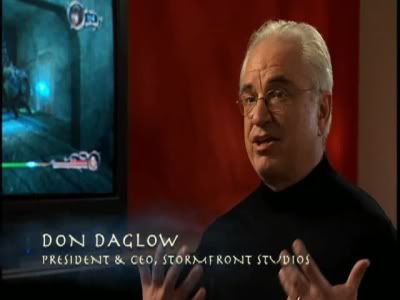
Don Daglow, (former) founder and CEO of Stormfront Studios
Let us travel back into game history time just a little. In April 2008, esteemed development studio Stormfront Studios announced its closure. The studio was famous for developing games such as Neverwinter Nights, Stronghold, Blood Wake, Demon Stone and Eragon. In 2008 Neverwinter Nights was honored at the 59th Annual Technology & Engineering Emmy Awards for advancing the art form of MMORPG games.
The studio’s closure was sudden and a very big loss for game professionals and fans. Although no direct explanation for their closure is given in the many articles announcing the studio’s ‘death’, (former) founder and CEO of Stormfront Studios Don Daglow was kind enough to elaborate on Stormfront’s closure, explaining to us what it is like working in a fast moving industry like the games industry. After briefly discussing the process that led to Stormfront’s closure, Mr. Daglow continued on a lighter note to explain what is currently keeping him busy and as passionate about the games industry as always.
Don Daglow: “I stayed too long on the idea of doing big games on consoles. We had a very large project where the publisher was acquired by a publisher, and the new publisher cancelled all the early-stage projects. And we were early-stage. We had a Wii game that a publisher just loved. And the head of marketing for that publisher decided that the Wii really wasn’t going to be a successful platform and that people wouldn’t keep buying Wiis. So they ordered that company not to do that title. So in ten days we lost 20 million dollars worth of business. And we knew we couldn’t pick that up. Because you always take months in between projects, getting the next one started, so you use up your money from one to the next. We could not have kept going on for very long, and realistically we wouldn’t have made a difference by trying to keep going. So we stopped. It was bad enough as it was.
So at that point you can either give up or you can say, okay, what am I meant to do? I did this for twenty years, in one setting. I did not change the company fast enough in accordance with how fast the world changed. But it’s a chance to start from scratch. And what I’ve seen in my life is that sometimes something bad has to happen to set us on the right path. And it’s encumbered upon us to figure out what’s that path. What is that thing that I have to do that will lead to future happiness and future success?
In this case, I hadn’t been able to work on online games, which are a passion of mine. Because it didn’t fit the Stormfront team. So this gave me the chance to start working on online games. Start working on social media games, which weren’t a part of our mix then because they were too small, we needed to do things big. Which was part of the problem. So some of what I do is original game design. Will it ever get fully made? We’ll see. And then I’m advising other companies and teams. Sometimes it’s just business stuff. Other times it’s helping teams with design or production or problems of building a small team.”
Above all, let us not forget Stormfront’s glory days as the developer with one of the longest creative histories in the industry, receiving countless awards from The Academy of Interactive Arts Sciences, G4 Television, BAFTA, The IGDA Game Developers Choice Awards, The EMMA Awards, SCEA, the Software Publishers Association and many magazines and websites. Video game history was made several times and the company was and will remain close to the hearts of many.
]]>In this first part of the “Idealism in the Industry” series we talk to Dr. David Nieborg, game journalist, researcher and teacher at the University of Amsterdam. He talks to us about the ‘problem’ of games journalism, the ‘games journalism lifestyle’ and his idealisic vision on what games journalism should be.
‘The problem’ of games journalism
David Nieborg: “First of all, the whole notion of there being something as games journalism is controversial. A significant part of those who report on games and game culture don’t think of themselves as journalists, but as fans, critics or bloggers. […] Ideally, journalism should be understandable, interesting, relevant and critical. And above all: journalists should only have to justify themselves to their readers. […] At the moment, there are very few professional, independent, traditional journalists writing about games. And in my eyes this also means that there are few good examples to follow.
Second of all, what characterizes games journalism in its current form is that it takes a very specific, unique position in respect to both the audience and the games industry. Readers seem to prefer short, subjective analysis above critical essays about games. The games industry in turn has an iron grip over the provision of news about (new) games and is thusly capable of initiating, steering and sometimes even preventing news reporting.
Several gamers and members of the games press seem to have the idea that what is good for the games industry is good for gamers. But this isn’t (always) the case. It’s the job of the games press to follow the industry with a critical eye.”
All about games
Nieborg raises a good point here. It is often forgotten that games journalism is still a form of traditional journalism and that we should always have a critical eye, instead of just bluntly stating what we see. Games journalism is currently in a trend where articles aren’t necessarily understandable, interesting, relevant and critical, but they are mostly entertaining and appeal to the masses.
If you’re a game journalist, think about this: did you have an idol? A journalist or a magazine crew that you adored and wanted to be like? I was a big fan of a certain Dutch game magazine since I was 11. I wanted to meet the writers, do what they do, write awesome articles in that wonderful magazine. Until I grew up and started asking myself: How many times can you put the word ‘boob’ in a serious journalistic publication? The more I started writing, the more websites and magazines I wrote for, the more I realized that a lot of influential media outlets are really not what I thought they were. Of course, jokes about boobs are funny at times, but the moment that cursing, talking about wild parties and ‘that hot chick that bends over in game X’, I don’t think it’s good journalism anymore. You shouldn’t just be out to please the crowd, you should entice them, make them passionate about what you write, excite them with something more.
But at times this can be problematic, since a lot of journalists lack knowledge. We should (want to) know and do research about the history of games, about games that laid the groundwork for other games that we have come to love. We should know about past and present cultural issues that are tied with games. Every game journalist should know not just who Miyamoto and Molyneaux are, but also who Don Daglow, Louis Castle and Gary Gygax are (– If you are a game journalist and you don’t know who Gary Gygax is; shame on you).
David Nieborg: “Think about the limited freedom that console gamers have. Contrary to PC gamers, console gamers don’t have a lot of freedom when it comes to adapting their games. Not so long ago it was very common to, especially with shooters, change everything that was possible (“modding”). New maps, avatars or entire storylines could be adapted by amateur developers. This mod-culture has been professionally stifled by the platform owners (Microsoft, Nintendo and Sony as well). Besides some exceptions (like LittleBigPlanet, Unreal Tournament 3 or Guitar Hero: World Tour), it isn’t possible to change or make additions to existing games. Amongst game journalists there is , [maybe] simply a lack of historic knowledge about a time where there were more freedoms.
In the end it is always a conscious assessment for developers and publishers to allow or implement, or not, something in a game or game console. Some things cost a lot of money or are tricky to do. But it is the task of game journalists to question the conscious removal or prohibition of for example the possibiliy to mod.”
Why change?
But why change something that seems to be running smoothly? Among game journalists, opinions are very divided. One half is looking to put more in their writings, and the other half thinks that what we have right now is just fine. They fear that we (the idealists) want to turn everything around, get rid of the old model and do something completely different. This, however, is not the case. Reviews, short articles and announcements are a big part of games journalism and they are indeed interesting pieces of information. We know that, and we do not want to get rid of them. I enjoy a nice review every once in a while, and I jump up excitedly when Sony or Capcom ancounce yet another sequel to one of my favourite games. But there is so much that we are not doing that could greatly expand the scope and range of games journalism.
David Nieborg: “In my opinion the current form of games journalist doesn’t ‘work’, I think that the medium (games) has a huge potential but that games journalism (but also consumers and the industry) is partly mis-recognising that potential. Making an effort for independent games journalism should mean that a (more) critical culture comes from gamers. Critical means nothing more or less than wondering why certain choices have been made by certain parties, and what the consequences of those choices have been. So that doesn’t necessarily mean that it should be from a negative perspective. In the long term it would be a good thing to look at the possibilities of the medium and not just at the next title in the franchise or new hardware.”
CG: Now, how can we arouse the interest for in-depth articles? What can game journalists do to broaden the topics covered in games journalism?
David Nieborg: “By writing good, readable, critical pieces with meaningful content. Nothing more, but nothing less. This doesn’t mean we should have long(er) or (more) intellectual pieces. It means we should ask questions that nobody asks, try to look a little bit further and don’t lose track of (game) history. Good articles, short ones, and well argued pieces as well, take a lot more time and imagination than a ‘simple’ review or a report of a press event.”
But […] a large group of game journalists don’t have a direct reason, or better yet an interest, in breaking with the (current) status-quo. When you have a job as a game journalist, and certainly a paid one, why should you want to innovate and think about the long term implications of your actions? Next to that, the games industry has even less interest in changing games journalism. At this moment there are many game websites, programs and magazines that are very effective in directly spreading the marketing material of the industry (think press releases, screenshots and announcements). Why would the industry want to re-educate an apparatus that would then make their jobs hard(er)?”
CG: Is it objectivity that we are looking for in games journalism?
David Nieborg: “Objectivity in journalism remains a pitfall. A journalist always makes choices that support or contradicts a certain idea or theory. What I think is more important is a critical attitude, independence and transparency. An objective game review doesn’t exist. But you can make sure that you look at the game with open eyes and try not to be influenced by others that have an interest with another opinion. If you use a quote from a press release or an employee from a marketing agency, be open about that. A lot of game journalists hide, mostly not consciously, that the information they pass on is directly coming from third parties. Whether that be colleague journalists, gamers, or employees from the games industry.”
CG: In what way does the ‘game journalist lifestyle’ influence articles? We’re talking goodies, parties with free drinks, food and elaborate shows?
David Nieborg: “There is indeed something you could call the ‘game journalist lifestyle’. I have tasted this lifestyle for two years and it does take strength and consciousness about your own position as a journalist if you don’t want to be influenced by this. Whatever you say, it remains bribery, no matter how indirect. One good turn deserves another. Free drinks are rare and free trips to five-star hotels have a price.
It’s a part of the industry and it isn’t unique (think about similar practices within car, fashion and movie journalism). But if this is the only way to get news, if this is the only reason to do what you do as a journalist, that would be a shame. In an ideal world, journalists would have direct access to developers and wouldn’t have to get their information at press events or through press agencies. For full disclosure, I have also been on press trips and been given (free) booze. But if I had to pick between a good, interesting interview that leads to news (or a good story), or a meaningless press trip (read: a drunken party with Dutch colleagues), I would have to go with the first.
[But] the parties have a function, namely networking and sharing information in an informal way. There’s nothing wrong with that, in its essence. But you have to constantly be aware of your position as a journalist. The moment that parties become a weapon, exclusion mechanism or a way to pressure journalists (like nowadays is often the case), that is a bad thing.”
CG: What kind of advantages would reaching your vision have?
David Nieborg: “In short term, not so much. In the long term, the medium of videogames can only evolve if there is an open, critical culture. Not everybody minds news about the eighth part of the Halo series, or the 13th expansion pack of The Sims. But I hope that the medium will develop. It has that possibility. Then, games will become more meaningful, which will lead to (meaningful) discussions, which will arouse new emotions and eventually help us to better understand the world.”
Spoken like a true idealist.
]]>
